
Vol. XVI, No. 2, February 2016
- Editor's corner
- Webinar on eatertainment this Wednesday
- Our CEO to give keynote at Entertainment Experience Evolution conference
- Scarcity of leisure time driving gentrification
- Connecting emotionally to build relationships with guests
- Raising the fidelity of LBEs with food and beverage
- Virtual & augmented reality - the ultimate disruption of place
- The children's entertainment market; the future ain't what it used to be
- Foundations Entertainment University registration open for next seminar program
- Uptick in cinema attendance; high fidelity movies win
Virtual & augmented reality - the ultimate disruption of place
Virtual Reality is no longer the science fiction we saw in the digital prison world of the Matrix movies and the holodeck in the StarTrek franchise. It has arrived and 2016 is predicted to be the year when virtual reality takes off to become the next big global tech phenomenon. Deloitte predicts 2016 sales of one billion dollars with $700 million in hardware sales and the remainder in content. Wired magazine predicts VR has the potential to create an equivalent “excitement of those first silent movies.” It seems that every week brings news of another development. We are on the edge of a virtual reality revolution - the launching of a new medium for entertainment and socialization.
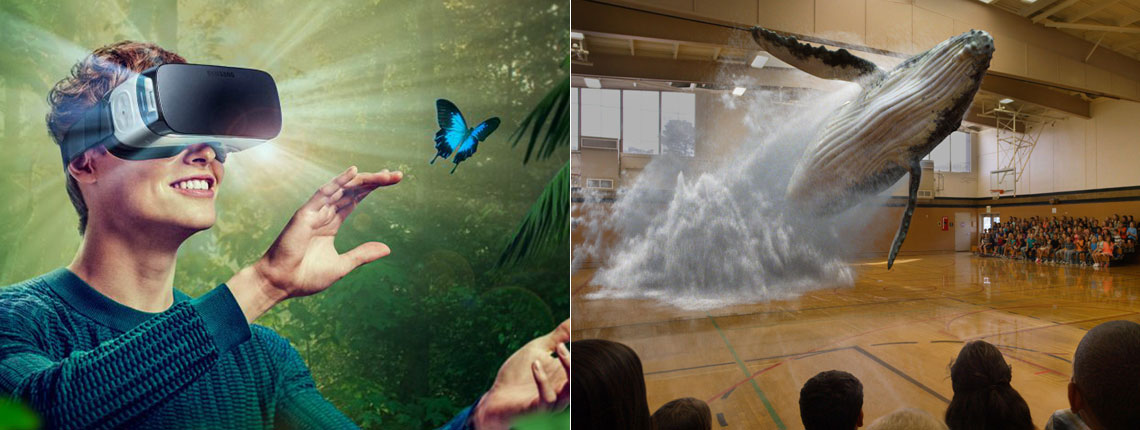
The disruption from virtual and augmented reality is much closer than most people realize
Initially the first generation high-grade systems will be on the expensive side, but just like all new digital technology, the quality quickly improves while the price drops. Moore's Law is sure to bring high-end VR within the reach of the average consumer in just a few years.
Just walk through any major electronics store and look at the prices for the latest model Smart 4K Ultra-HD big screen televisions. You can buy a high quality 65-inch set for under a $1,000. It wasn't that many years ago you would have paid that much for a 42” non-smart just HD set.
The graph below shows how rapidly the price has declined for televisions and computers and peripheral equipment based on equivalent products over the past ten years. A TV that would have cost you $1000 in 2005 only cost you $127 in 2015 for the same size and quality set. Of course, instead you probably would have spent $500 in 2015 for a much larger and much higher quality set.
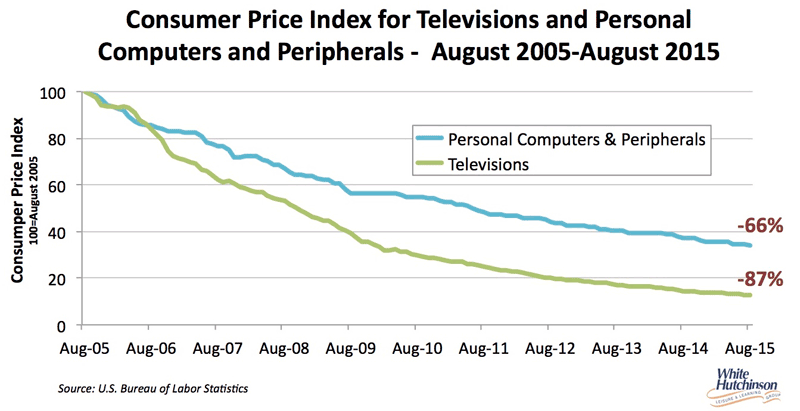
Since 2005, computers and their peripheral equipment have decreased in price by 10% annually and TVs by 18%. Back in the early days of computers in 1997, prices dropped even faster, at 27% annually for the next five years. There is no reason to not believe that a new compelling technology like VR won't increase in quality and decrease in price just as fast as we have seen with other new electronic technology. What that means is by 2020, a VR set-up that costs $1,499 today, such as the new Rift VR headset from Oculus VR and a PC with the necessary horsepower, could easily drop in price to less than $500, but be even higher quality with more features than today's version.
The history of technology adoption also indicates how rapidly VR is likely to become mainstream. The pace of technological change is accelerating all the time as is the speed with which the consumer is adopting it. Just look at the chart below, which documents the number of years it, took for one quarter of the US population to use a new technology. The telephone took 35 years to reach what we can define as the mass market (when it is used by 25% of the population), the television took 26 years, the PC took 16 years, the World Wide Web took 5 years and the smartphone was used by 25% of people in the US in a mere 3 years.
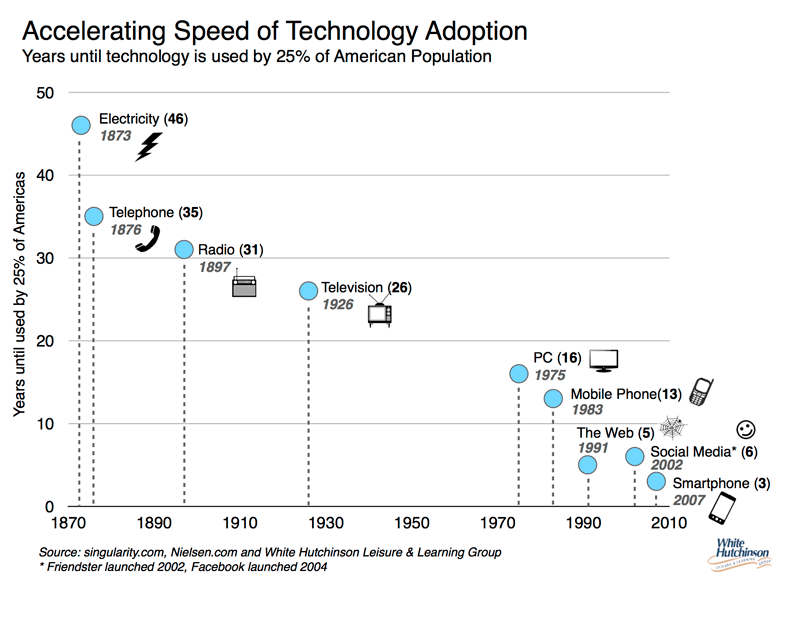
Today we live in an age with exponential improvements to technology; five years today is the equivalent of ten or more years at the end of the 20th Century. The next five years will see advancements in VR far greater than you might imagine.
What has occurred in the last few years to move VR forward so rapidly is that like the PC and the smartphone, virtual reality isn't so much a single new technology as a bunch of related ones in advanced development stages - motion tracking, 3-D capture, ultra high resolution displays, fast graphic chips - all coming together at the same time with the backing of major companies with access to big bucks for development combined with a library of 3-D software developed for games and other applications.
VR is the first entertainment medium that's native to smartphones. That's the reason so many people are excited about the space. People can now consume an immersive experience in a compelling way right on their phones with relatively simple inexpensive equipment such as Google Cardboard. Even the high-end more expensive headsets are based on smartphone technology. It's the smartphone technologies that enable VR, making it available so quickly over the last couple of years and the reason to it should gain a large market in the near future.
The major players - Sony, Facebook and Samsung are pouring billions, yes billions of dollars into virtual reality. Even Apple is working on VR. Apple recently acquired Flyby Media that makes image-recognition software used to map a user's surroundings and they have a team of over 100 working on VR and mixed reality (AR) technologies. It's no longer the hype and false start for VR that occurred back in the 1990s when the needed technologies - the hardware, the computing power and other technologies needed, didn't exist. Today they do and new technologies such as spatial audio (allows users to experience sounds in a more natural way) and haptic feedback (the sense of touch) are in the formative stages of being added to VR to make it even more real.
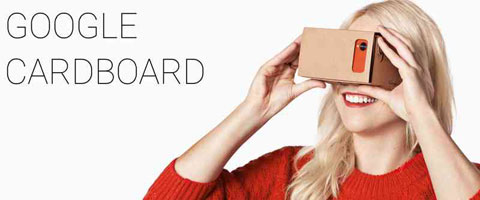
In addition to the Oculus Rift headset version that is now on sale, in 2015 we had the introduction of the less sophisticated $15 Google Cardboard version (that's what it's made of) that gives 3D views using a smartphone as well as the Samsung Gear and other headsets using smartphones. Also coming this year we will have the launch of the HTC Vive and the Sony Project Morpheus headsets.
Of course technology hardware is no good without content. Initially, the majority of in-home use will be with gamers. The Game Developers Conference's State of the Industry survey found that the number of game development companies working on virtual reality gaming content more than doubled in the past year. Reports from the CES show in January put the number of VR games in the development pipeline at more than 100. AltspaceVR'sversion of the highly popular social role-playing Dungeons & Dragons in VR and their new Sketchy Quiz game are early examples of how people will congregate in virtual places and spaces. And the movie studios, as well as the streaming video services including Netflix and Hulu have announced upcoming VR content. The 2016 Sundance Film Festival featured 30 VR experiences, including feature films.
A related technology, augmented reality is also in development, but it has not yet reached the stage of being ready to mass market to consumers. AR, unlike VR where you are immersed in a digital world, overlays, projects virtual objects, holograms, onto the world around you rather than replacing it completely. Thus it is also called mixed-reality, as it mixes the real and the virtual. One big plus for AR is that it uses headgear that is much more comfortable, more like wrap around glasses. Experts believe that is only a few years off and that AR will become more popular than VR. Large companies including Google and Alibaba Group, each with over a one-half billion-dollar investment in Magic Leap, and Microsoft with its HoloLens goggles, are investing heavily in augmented reality. AR will likely be incorporated in the design of most virtual reality goggles in the next few years because of the ease of inclusion. For a preview of the type of experience AR will offer, check out this just released video by Microsoft for their Hololens.
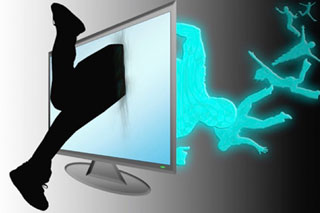
VR and AR could be as disruptive to location-based entertainment, cultural and sport events as TV was to movie theaters. VR offers a completely new consumer at-home experience. Up until now you sat back in one world and observed media content at a distance on a flat 2-D screen, whether on a computer, television, tablet or smartphone screen. Even with video games, you could have an avatar, but your avatar inhabited a world on the other side of the screen. To have a real entertainment, cultural or sport event experience, to be immersed in the experience, you had to leave your home and visit some “place.” You were in the place. VR is about to change that with what is called “presence.” Presence is commonly equated with the concept of immersion, the perception of actually being present in a nonphysical but lifelike virtual world, interacting with that world all the while the virtual world is aware of your presence and reacting to you - yes, exactly what a real world experience is. There is a strong sense of embodiment, you consider your virtual body you inhibit in VR to be your own physical self. And as haptic feedback technology advances, the virtual experience will give a full sense of physical interactivity, long the exclusive purview of real world and most FEC-type attraction experiences. You'll feel like you're really present there. The emotional intensity of a VR experience is far greater than current flat screen experiences.
Now with VR, you move into the other side of the screen, you are teleported to the middle of a multi-dimensional world, at some entertainment venue, at the music concert, walking thought the museum or zoo, sitting in a prime seat at the sport event or interacting in some game environment with your friends. And with AR, entertainment is super imposed on your home environment. The VR and AR experiences will be so much more compelling than the options we now have on our flat screens. There is no longer a need to leave your comfortable lounge chair to have the experience of place. These technologies are poised to fundamentally transform personal entertainment as we know it, potentially delivering a long-term disruptive impact that will exceed the disruptive digital impacts of the past few decades.
AR or VR will also disrupt human interaction for both in-person, out-of-home socialization and current screen-based 2-D social media, as in VR you and your friends will be able to meet in a virtual world when you literally inhabit your avatar in that world or with AR you can have a conversation with family members or friends across the country as if they were in the same living room. Place and its associated experience and people will be virtually transported to be experienced in our homes.
We are already seeing early versions of this being used to market cruise lines, restaurants, resorts and travel destinations and even non-profits. The New York Times is producing VR documentaries for its print subscribers. You can now see Google Street View in VR. Both are available using Google Cardboard. Football has already embraced VR. The NFL brought VR to this year's Super Bowl for attendees of the NFL Experience and visitors to Super Bowl City. Now VR is just waiting for the NFL and other sports to give it the go for live steaming VR broadcast of games. And marketers are already embracing VR. Microsoft is developing their Room2Room AR system to project a life-size 3D projection of the person you are speaking to into a chair across from you.
VR and AR are about to completely change how people interact with the world and with each other. They will create a transformative sea change to experiences of all types and become a major disruption to the concept of "place" as we knew it. You will not longer have to visit a physical place, as the place will be transported to you. VR and AR will have a powerful appeal that will just increase the seismic shift in how we live, work and play to the digital world and away from increasingly rarer physical real world experiences.
No, this won't happen tomorrow, but the disruption is fast approaching, probably in the number of years you can count on one hand. We are on the edge of a virtual and mixed reality entertainment revolution. The party's just getting started
The quality of the at-home entertainment experience is about to become exponentially better and more mesmerizing. VR and AR will likely become as disruptive to location-based entertainment as TV was to the movie theaters (see movie theater article this issue). Just like what happened to cinemas when recent movies could be viewed at home at a lower cost and the box office started a long-term decline, a new world of VR and AR entertainment experiences is about to disrupt the location-based entertainment landscape as we now know it as more of our entertainment experiences migrate to the digital world and away from the physical world. Get ready for VR-tainment and AR-tainment.
This is something that all types of location-based leisure, including entertainment and FEC venues of all types, need to start planning for to stay ahead of the curve. They need to start raising the Fidelity of their in-venue experiences to counter the attractiveness of the VR and AR at-home entertainment experience that is on the horizon.
Postscript:
VR-tainment is also being introduced in out-of-home entertainment venues including The VOID and Zone Latency. An industry colleague, Kevin Williams, publisher of The Stinger Report, in partnership with the Road to VR website, has produced a two-minute video of the VR attractions seen at this past November's IAAPA show. Click here to view it. For daily news on VR developments, subscribe to the Road to VR's newsletter.
Vol. XVI, No. 2, February 2016
- Editor's corner
- Webinar on eatertainment this Wednesday
- Our CEO to give keynote at Entertainment Experience Evolution conference
- Scarcity of leisure time driving gentrification
- Connecting emotionally to build relationships with guests
- Raising the fidelity of LBEs with food and beverage
- Virtual & augmented reality - the ultimate disruption of place
- The children's entertainment market; the future ain't what it used to be
- Foundations Entertainment University registration open for next seminar program
- Uptick in cinema attendance; high fidelity movies win


